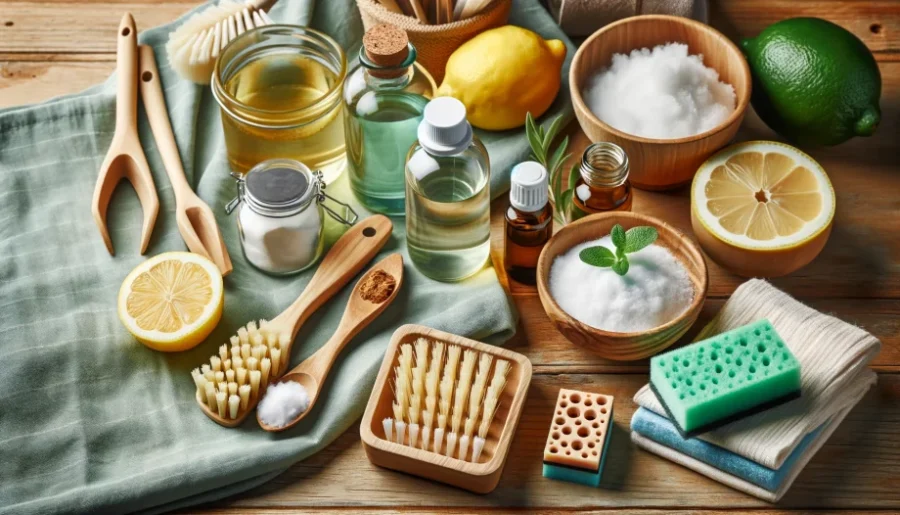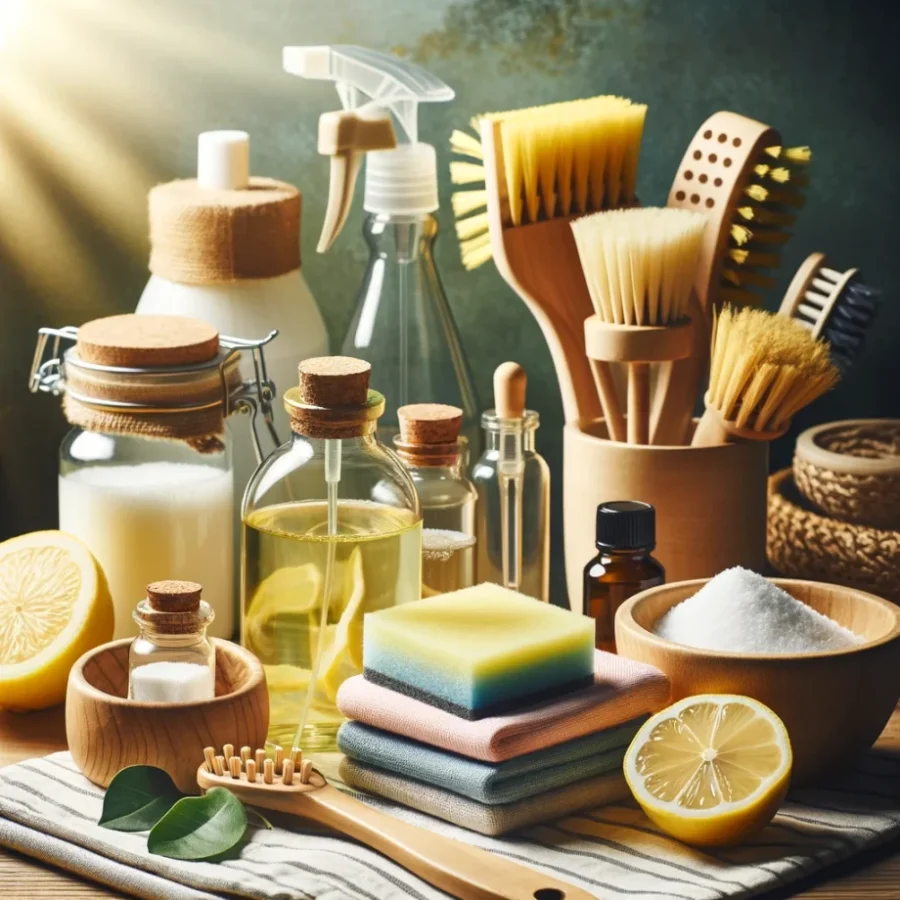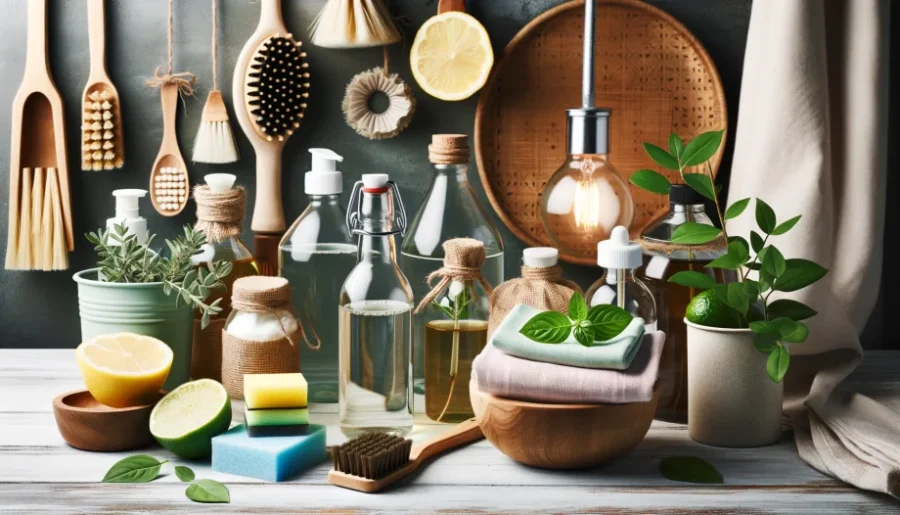
Discover eco-friendly cleaning solutions that are kind to the planet and your home. Learn how natural ingredients can lead to a cleaner, greener lifestyle.
Eco-Friendly Cleaning Solutions
Key Takeaways:
- Eco-friendly cleaning solutions utilize natural ingredients like vinegar, baking soda, and essential oils to create effective and non-toxic cleaning products.
- These solutions are better for the environment, safer for health, and can reduce the use of harmful chemicals and single-use plastics in our daily cleaning routines.
Eco-friendly cleaning solutions are changing the game in home care.
By harnessing the power of natural ingredients, we can keep our spaces sparkling while protecting the environment.
Join us as we dive into the world of sustainable cleaning, where health, hygiene, and eco-consciousness go hand in hand.
Eco-Friendly Cleaning Solutions
Eco-friendly cleaning solutions are gaining popularity as people seek alternatives to conventional products that can be harsh on the environment and health.
These natural and green cleaning solutions utilize ingredients like vinegar, baking soda, and essential oils to effectively clean and disinfect homes without the need for toxic chemicals.
The Shift to Green Cleaning:
- Awareness and Demand: Growing awareness of environmental and health impacts is driving the demand for eco-friendly cleaning solutions.
- Sustainable Ingredients: Natural ingredients are at the heart of green cleaning, offering a safer and more sustainable alternative to harsh chemicals.
Benefits of Eco-Friendly Cleaning:
- Health and Safety: Reducing exposure to toxic chemicals can improve indoor air quality and overall health.
- Environmental Impact: Natural cleaning solutions minimize pollution and waste, contributing to a healthier planet.
1. Vinegar for Wood and Tile Cleaning
Vinegar is a versatile and eco-friendly ingredient for cleaning various surfaces in your home. Its acidic nature makes it effective for cutting through grime and leaving surfaces shining.
Cleaning Wood Floors:
Mix 1/4 cup of vinegar with a half gallon of warm water to create a gentle yet effective cleaning solution for wood floors. This mixture can remove dirt without damaging the wood’s finish.
For Painted Wood:
A solution of 1 teaspoon of washing soda in 1 gallon of hot water can be used to clean painted wood surfaces without stripping the paint.
Brick and Stone Tiles:
Vinegar’s natural acidity also makes it suitable for cleaning brick and stone tiles. It can help remove stains and restore the natural beauty of these materials.
By incorporating vinegar into your cleaning routine, you can achieve a clean and fresh home while minimizing your environmental impact.
2. Furniture Polish
Creating your own eco-friendly furniture polish is a simple and effective way to care for your wood furniture without using harsh chemicals.
For Varnished Wood:
A mixture of a few drops of lemon essential oil in 1/2 cup of warm water can be used as a polish for varnished wood furniture. The lemon essential oil not only cleans but also leaves a pleasant, fresh scent.
For Unvarnished Wood:
For unvarnished wood, a mix of 2 teaspoons each of olive oil and lemon juice can be applied with a soft cotton cloth. This combination nourishes the wood while adding a natural shine.
By using these natural ingredients, you can keep your furniture looking beautiful while also being mindful of the environment.
3. Garbage Disposal Cleaner
Keeping your garbage disposal clean and odor-free is easy with natural ingredients like baking soda and vinegar. Here’s how to do it:
Cleaning Process:
- Sprinkle about 1/2 cup of baking soda into the garbage disposal.
- Pour 1 cup of white vinegar over the baking soda. You’ll see fizzing as the two ingredients react, which helps break down food residue and grime.
- Let the mixture sit for about 10 minutes to work its magic.
- Rinse with hot water while running the disposal to clear out any remaining debris.
This simple and eco-friendly method ensures that your garbage disposal remains fresh and clean without the need for harsh chemicals.
4. Eco-Friendly Cleaning Brands

Several brands are known for their commitment to eco-friendly cleaning products.
For example, Blueland offers zero-waste cleaning kits with refillable packaging, while Dropps provides biodegradable laundry and dishwashing pods.
Ecover is another brand that is known for its range of eco-friendly products, including laundry detergent and dish soap, all with transparent ingredient lists.
By choosing products from these brands, you can ensure that your cleaning routine is effective and environmentally friendly.
You can access Amazon’s website to gather information on eco-friendly cleaning brands and read product reviews. Here is a partial list of some of the best eco-friendly cleaning brands.
Eco-Friendly Cleaning Products on Amazon Table
| Brand | Product Types | Features |
|---|---|---|
| Seventh Generation | Laundry detergents, dish soaps, all-purpose cleaners | Plant-based ingredients, biodegradable formulas |
| Mrs. Meyer’s | Hand soaps, multi-surface cleaners, dish soaps | Cruelty-free, made with essential oils |
| Ecover | Laundry detergents, dish soaps, all-purpose cleaners | Plant-based and mineral ingredients, biodegradable |
| Method | All-purpose cleaners, hand soaps, laundry detergents | Non-toxic, biodegradable, uses recycled packaging |
| Biokleen | Laundry detergents, all-purpose cleaners, stain removers | Concentrated formulas, no artificial fragrances |
| Dr. Bronner’s | Castile soaps, hand sanitizers | Organic ingredients, fair trade, multi-use |
| Blueland | Cleaning tablets (glass, bathroom, multi-surface) | Refillable containers, no single-use plastic |
| ECOS | Laundry detergents, all-purpose cleaners, dish soaps | Carbon-neutral manufacturing, renewable energy used |
| Better Life | All-purpose cleaners, dish soaps, floor cleaners | Plant-derived ingredients, non-toxic |
| Puracy | Laundry detergents, hand soaps, multi-surface cleaners | Hypoallergenic, biodegradable, no harsh chemicals |
Please note that availability and specific product offerings may vary on Amazon. It’s always a good idea to check the product listings for the most up-to-date information.
5. DIY Solutions

Creating your own eco-friendly cleaning solutions is not only cost-effective but also ensures that you know exactly what’s going into your cleaning products.
Here are some simple and effective DIY cleaning recipes:
All-Purpose Cleaner:
- Mix equal parts white vinegar and water in a spray bottle.
- Add a few drops of essential oils like tea tree or lavender for added cleaning power and a fresh scent.
- Use this solution to clean countertops, glass, and other surfaces.
Glass Cleaner:
- Combine 1/4 cup white vinegar, 1/4 cup rubbing alcohol, 1 tablespoon cornstarch, and 2 cups of water in a spray bottle.
- Shake well before use.
- Spray on glass surfaces and wipe clean with a lint-free cloth for a streak-free shine.
Floor Cleaner:
- Mix 1/2 cup white vinegar with 1 gallon of warm water.
- Add a few drops of essential oil for a pleasant scent.
- Use this solution to mop tile or vinyl floors. For hardwood floors, reduce the vinegar to 1/4 cup.
Bathroom Cleaner:
- Combine 1/2 cup baking soda, 1/4 cup hydrogen peroxide, and 1 teaspoon liquid dish soap in a squeeze bottle.
- Apply to bathroom surfaces, let sit for a few minutes, then scrub and rinse for a sparkling clean.
Toilet Bowl Cleaner:
- Sprinkle baking soda into the toilet bowl, then pour in white vinegar.
- Let the mixture fizz for a few minutes, then scrub with a toilet brush and flush.
By using these DIY eco-friendly cleaning solutions, you can reduce your environmental impact while keeping your home clean and fresh.
By choosing eco-friendly cleaning solutions, you can reduce your environmental impact, protect your health, and still enjoy a clean and fresh home.
6. Disposal of Eco-Friendly Cleaning Products
Proper disposal is crucial to ensure that eco-friendly cleaning products remain eco-friendly even after their use.
Recycling Packaging:
- Check if the packaging is recyclable and dispose of it in the appropriate recycling bin.
Composting Biodegradable Ingredients:
- Some natural ingredients can be composted. Check the product label for compostability.
Hazardous Waste Disposal:
- Even eco-friendly products may contain elements that require special disposal. Follow local guidelines for hazardous waste.
7. Cost Comparison
Eco-friendly cleaning solutions can be cost-effective compared to conventional products.
Here’s a basic cost comparison:
| Product | Conventional Price | Eco-Friendly Price | DIY Price |
|---|---|---|---|
| All-Purpose Cleaner | $3.00 | $4.00 | $1.00 |
| Glass Cleaner | $2.50 | $3.50 | $0.50 |
| Laundry Detergent | $10.00 | $15.00 | $5.00 |
*Prices are approximate and may vary by brand and location.
8. Health Benefits

Choosing eco-friendly cleaning products can have significant health benefits.
Reduced Chemical Exposure:
- Minimize exposure to harmful chemicals that can cause skin irritation, allergies, or respiratory issues.
Improved Indoor Air Quality:
- Avoid volatile organic compounds (VOCs) that can contribute to indoor air pollution.
Safer for Children and Pets:
- Natural ingredients are generally safer for homes with children and pets.
9. Tips for Transitioning
Transitioning to eco-friendly cleaning can be a smooth process with the right approach.
Start Small:
- Begin by replacing one or two products and gradually expand.
Read Labels:
- Look for certifications and ingredients to ensure products are truly eco-friendly.
DIY When Possible:
- Consider making your own cleaning solutions for a cost-effective and customizable option.
10. Eco-Friendly Cleaning Tools
Complement your eco-friendly cleaning solutions with sustainable tools.
Bamboo Brushes:
- Opt for brushes made from bamboo, a renewable resource.
Microfiber Cloths:
- Reusable microfiber cloths can effectively clean surfaces without chemicals.
Refillable Mop Systems:
- Choose mop systems that allow you to refill and reuse the mop pads.
11. Certifications and Labels
Understanding certifications and labels can help you choose genuine eco-friendly products.
EPA’s Safer Choice:
- Products with this label meet strict safety and environmental standards.
Green Seal:
- Look for the Green Seal certification for products that have been independently verified for their eco-friendliness.
12. Supporting Local and Small Businesses
Supporting local and small businesses that produce eco-friendly cleaning products can have a positive impact on the community and economy.
Shop Local:
- Purchase from local stores or farmers’ markets to reduce transportation emissions.
Support Small Businesses:
- Choose products from small businesses that prioritize sustainability and ethical practices.
FAQ: Eco-Friendly Cleaning Strategies
Embracing eco-friendly cleaning strategies is essential for a healthier home and planet. These FAQs address common questions about green cleaning, helping you make informed choices for a sustainable lifestyle.
Q: Why should I use eco-friendly cleaning products?
A: Eco-friendly products use natural, biodegradable ingredients, reducing environmental harm. They’re safer for your health and save costs in the long run.
Q: Can I make my own eco-friendly cleaning products?
A: Yes! DIY cleaning solutions with vinegar, baking soda, and essential oils are effective and minimize environmental impact.
Q: Why are microfiber cloths better than traditional cleaning cloths?
A: Microfiber cloths are more effective at trapping dirt and dust, and they’re reusable, reducing waste and long-term costs.
Q: How does steam cleaning work and why is it eco-friendly?
A: Steam cleaning uses water and heat to sanitize surfaces without chemicals, making it safe and eco-friendly.
Q: What are the advantages of using a HEPA filter vacuum?
A: HEPA filter vacuums capture 99.97% of small particles, improving air quality and reducing allergens.
Q: Why should I choose reusable cleaning tools?
A: Reusable tools reduce waste and are often more durable and effective than disposable options.
Q: How does composting food waste benefit the environment?
A: Composting reduces landfill waste and produces nutrient-rich soil, supporting sustainable agriculture.
Q: How can I reduce water usage at home?
A: Fix leaks, install water-efficient devices, and adopt water-saving habits like shorter showers and turning off taps when not in use.
Conclusion: Embracing Eco-Friendly Cleaning Solutions
Adopting eco-friendly cleaning solutions is a powerful step towards a healthier home and a more sustainable planet.
By choosing natural ingredients and reusable tools, we can reduce our environmental footprint and create a safer living space.
Benefits of Eco-Friendly Cleaning:
- Healthier Home Environment: Natural cleaning products reduce exposure to harmful chemicals, ensuring a safer space for you and your loved ones.
- Positive Environmental Impact: Eco-friendly solutions minimize pollution and waste, contributing to a healthier planet.
- Cost Savings: Many eco-friendly cleaning methods, like DIY solutions, can be more economical in the long run.
Taking Action:
- Start Small: Begin by replacing one or two conventional products with eco-friendly alternatives and gradually expand your green cleaning arsenal.
- Spread the Word: Share your experiences and tips with friends and family to encourage wider adoption of eco-friendly cleaning practices.
Final Thoughts:
Embracing eco-friendly cleaning solutions is not just about keeping our homes clean; it’s about taking responsibility for our impact on the environment and future generations. Let’s continue to explore and adopt sustainable practices that promote a cleaner, greener world.
Learn more: Mastering Zero-Waste Living: 7 Easy Tips and Tricks
Eco-Friendly Cleaning Solutions: Resources
In our pursuit of a cleaner and greener environment, it’s essential to choose cleaning solutions that are not only effective but also safe for our health and the planet.
The U.S. Environmental Protection Agency (EPA) offers a wealth of information on eco-friendly cleaning products and practices.
Their Safer Choice program helps consumers, businesses, and purchasers find products that perform well and contain ingredients that are safer for human health and the environment.
Below are some resources to help you make informed decisions about eco-friendly cleaning solutions:
- Identifying Greener Cleaning Products: Learn about the EPA’s Safer Choice program, which certifies products containing safer ingredients for human health and the environment. Read more.
- Search Products that Meet the Safer Choice Standard: Use this tool to find cleaning and other products that meet the Safer Choice Standard. Search here.
- Why Buy Greener Products?: Understand the importance of choosing greener products for human health and environmental impact. Learn more.
- Sustainable Marketplace: Greener Products and Services: Discover how greener purchasing can reduce climate impacts, improve community health, prevent pollution, and increase industry competitiveness. Explore.
- Safer Choice for Consumers: Find certified products, learn about the Safer Choice label, and access resources to make safer choices in your community. Visit Safer Choice.









